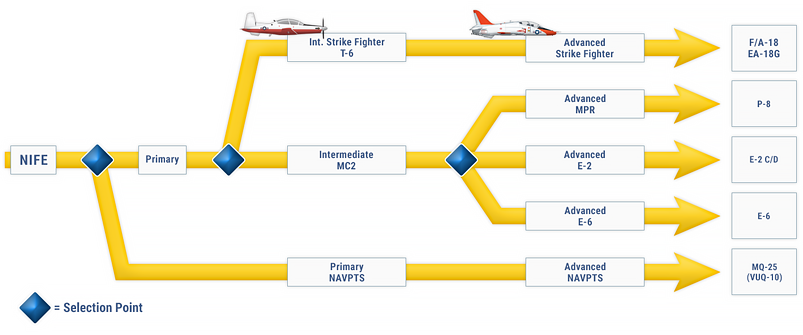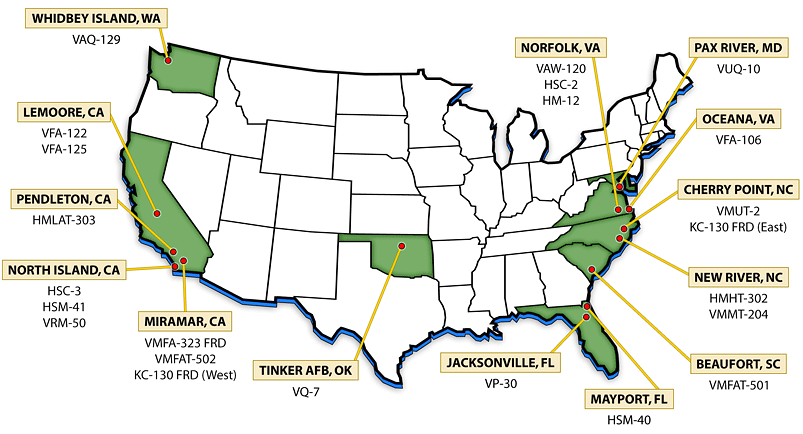 Chief of Naval Air Training
// NAS Corpus Christi
Chief of Naval Air Training
// NAS Corpus Christi
Naval Flight Officer (NFO)
Aviation Training Pipeline
CNATRA conducts four NFO training pipelines - Strike Fighter, Airborne Early Warning (AEW), Maritime Patrol (MPR), and Take Charge and Move Out (TACAMO). Training for all four NFO pipelines is conducted at Training Air Wing SIX at NAS Pensacola, Florida. All NFOs begin their Primary training at VT-10 in the T-6A Texan II, learning the basic skills of aviation, visual and instrument navigation, and communications. The training consists of academics, navigation and communication trainers, high fidelity simulators, and instrument, navigation, and formation flights. Students selected for land-based aircraft (MPR and TACAMO) move on to Advanced training at VT-4, while carrier-based students (Strike Fighter and AEW) receive additional T-6A training. Students selected for Strike Fighter move on to Advanced training at VT-86, while AEW students proceed to VT-4.

Advanced Training at VT-4 and VT-86 provides tactical training to student NFOs that tests and prepares them for their future fleet aircraft. Upon completion of Advanced training, NFOs receive their wings of gold and move on to their respective Fleet Replacement Squadron (FRS).
MPR, TACAMO, and AEW students receive Advanced training at VT-4 utilizing the Multi Crew Simulator (MCS). The MCS is a reconfigurable trainer that allows students to learn how to employ the systems and tactics of their fleet aircraft in real world mission scenarios with multiple crew members and multiple aircraft. Training focuses on Crew Resource Management (CRM), communications, and sensor utilization while learning tactical procedures for various missions. Students learn how to utilize RADAR (including Synthetic Aperture and Inverse Synthetic Aperture), Data Links, Electro-Optic/Infra-Red cameras, Electronic Surveillance, acoustic, and navigation and communications systems.
MPR students utilize these systems to perform Anti-Surface and Anti-Submarine Warfare, Electronic Warfare, Intelligence Surveillance and Reconnaissance, and Search and Rescue missions. Upon graduation, NFOs continue to VP-30 in Jacksonville, FL for training in the P-3C, EP-3E, or P-8A.
TACAMO students learn complex communications protocols, prioritization and CRM skills that prepare them for training in the E-6B at VQ-7 in Oklahoma City, OK.
AEW students learn Command and Control and Air Intercept Control, and after graduation move on to VAW-120 in Norfolk, VA for training in the E-2C or E-2D.
Strike Fighter NFO training is conducted at VT-86 utilizing specially modified T-45C simulators and aircraft incorporating the Virtual Mission Training System (VMTS). VMTS allows NFOs to train for air-to-air or air-to-ground missions using a synthetic RADAR that mirrors the capability of the F/A-18. Utilizing a data link network and an instructor ground station, students perform complex missions against multiple air and surface targets. NFOs train for Strike, Close Air Support, and All Weather Intercept missions. After graduation, Navy NFOs will train in the F/A-18F with either VFA-106 in Virginia Beach, VA or VFA-122 in Lemoore, CA, or the EA-18G with VAQ-129 in Whidbey Island, WA. Marine Corps NFOs will train in the F/A-18D with VMFAT-101 in Miramar, CA.







